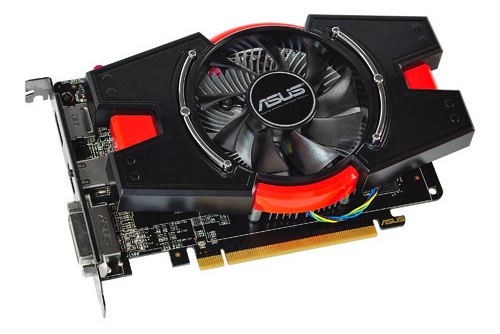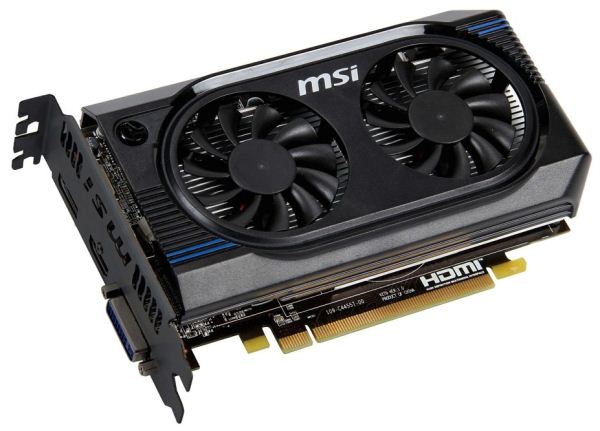AMD Radeon HD 7750 Launch Recap
by Andrew Cunningham on February 20, 2012 2:00 PM EST- Posted in
- AMD
- Radeon
- Radeon HD 7000
- GPUs
Unlike some of our launch recaps (including the 7770 recap article, which covers a whopping ten cards and should come later today), we have only a handful of cards to cover in the Radeon HD 7750 lineup—while our review noted that neither it nor the 7770 are a slam dunk from a price/performance perspective, at present the 7750 has a few things that make it interesting: (1) it's the cheapest way to get in on AMD's GCN architecture, coming in right above $100, and (2) it's one of the fastest cards you can get that doesn't require external power, making it a slightly better candidate as a drop-in graphics card for an OEM PC with a lackluster power supply.
We've only got three cards, and they'll go by quickly. Let's get started.
|
ASUS |
HIS |
MSI |
|
| Part Number | HD7750-1GD5 | H775F1GD | R7750-PMD1GD5/OC |
| Core Clock | 820 MHz | 800 MHz | 830 MHz |
| Memory Clock (Effective) | 1150 MHz (4600 MHz) | 1125 MHz (4500 MHz)* | 1125 MHz (4500 MHz) |
| Dimensions in inches (dimensions in mm) | 7.8 x 5 x 1.7 (198.12 x 127 x 43.18) | 7.13 x 4.80 x 1.34 (181 x 122 x 34) | 6.69 x 4.37 x 1.50 (170 x 111 x 38) |
| Included accessories | DVI to VGA adapter | DVI to VGA adapter* | DVI to VGA adapter |
| Warranty | 3-year | 2-year | 3-year parts, 2-year labor |
| Price (Newegg) | $109.99 | $109.99 | $119.99 |
First, indulge me in a rant about card dimensions—the manufacturers for these three cards provided their dimensions in three different units (inches, centimeters, and millimeters)—for consistency's sake I've converted all units as needed and listed both inches and millimeters above. However, it'd be nice if everyone could unify around one unit of measurement to make these apples-to-apples comparisons easier and to cut down on inconsistencies between manufacturers—the card dimensions above all vary quite a bit for cards that, at least judging from pictures, appear to be pretty close to the same size (note the height and the length of each card, in particular)—this was especially true in our 7970 launch recap, where sizes varied wildly among cards that all used pretty much identical PCBs and coolers. My point being, these figures are provided above, but without physical access to each card and a ruler, it's difficult to ensure accuracy. There, I've said my piece.
Carrying on: Common to all of these cards are the basic characteristics of the 7750 series—1GB of GDDR5 memory on a 128-bit bus, Eyefinity support, DVI-I, HDMI, and DisplayPort outputs, and all of the features inherent to GCN (including DirectX 11.1 and OpenGL 4.2 support and a host of others). All of the cards are pretty light on accessories, which is par for the course once you get down into this price range—multiple adapters and bundled HDMI cables are for more expensive cards.
ASUS (Product page)

ASUS' card sports a very mild overclock on both the core and the memory, and when I say "very mild" I mean about 2.5% and 2.2%, respectively. Still, if you prefer not to overclock, this card is the only one in the lineup with any sort of memory overclock, and it includes the best warranty in the lineup (three years, which covers both parts and labor). This card also uses a single-fan cooler that, in pictures, appears to take up about a slot and a half of space in a case—this card, along with the HIS card, should be a good option for those with cramped cases.
Overall, given this product's price and clocks, I'd say it's the best value here by a narrow margin from a performance perspective, though the MSI card's larger fan may be better for those hoping for slightly better overclocks.
HIS (Product page)
This card is the only one in our lineup running at stock clocks out of the box, though intrepid overclockers should be able to match (or best) the other cards' wimpy stock overclocks without much trouble. The card's two year warranty is also the shortest of the three, though it costs the same as the ASUS card.
HIS calls the single-fan cooler on this card an "iCooler," and its claim to fame is silence—HIS claims it generates less than 28 dB of noise at idle, and a nice analysis over at TechPowerUp seems to confirm this (at both idle and load, the fan is still within a few dB of quieter cards like the 5670 and louder ones like the 7770). Quiet computing enthusiasts may find something to like here.
*: Note that as of this writing, this card's Newegg product page lists a memory clock of 1375 MHz (5500 MHz effective), while the official HIS product page cites a speed of 1125 MHz (4500 MHz effective). Since 1125 MHz is the correct stock speed for this card, I believe that the values from HIS are correct—don't order this card thinking you're getting a massive memory overclock.
MSI (Product page)
The MSI card's main differentiating factor is its large dual-fan, dual-slot cooler, which also includes a large heatsink—overclockers may want to look at this one over the other two, though the fancier cooler drives this card's price up $10 compared to the competition. From the factory, the MSI card's 830 MHz core clock edges out the ASUS card's 820 MHz clock, but it sticks with the stock memory clocks (and that extra 10 MHz overclock is a rounding error, in any case). The warranty here falls right in the middle—it has a three year warranty on parts, but only a two year warranty on labor.
*: MSI's product pages for all 7000-series cards use the same accessories list, and notes that "accessories will probably be different according to the different selling areas of product models." The accessories list includes a DVI to VGA adapter, a CrossFire bridge, a Mini DisplayPort to DisplayPort adapter, and a 4-pin to 6-pin power adapter—since the 7750 can't use the last three accessories in that list, it's safe to assume that a DVI to VGA adapter is all you'll get with this card.












20 Comments
View All Comments
dagamer34 - Monday, February 20, 2012 - link
When are we going to get Thunderbolt support in video cards?Death666Angel - Monday, February 20, 2012 - link
As soon as there are non-Apple displays. Looking at the adoption rate of DP, I'd say 2 years until we have some more regular options on that front. Not that I need it, though. :-)xdrol - Monday, February 20, 2012 - link
Thunderbolt = Display Port, so you already got that.PhoenixEnigma - Monday, February 20, 2012 - link
Sadly, no. You can drive a Display Port display off of a Thunderbolt port, but not vice versa. Which means that once stocks of LED Cinema Displays are gone, there's one less competitor in the vast majority of the 27" 1440p display market.tipoo - Monday, February 20, 2012 - link
Huh Thunderbolt in video cards? Do you mean Displayport perhaps? Thunderbolt has a lot of bandwidth on its own, going through a video card that's also using PCI-E bandwidth probably would be hard to implement, and still underperform. That makes me wonder though, if you have a dGPU where would the thunderbolt ports be? If they were on the motherboard it wouldn't be connected to the GPU, if they were on the GPU you'd have that bus problem.MySchizoBuddy - Monday, February 20, 2012 - link
It sucks that even low end cards are now double slot cards. The motherboard manufacturers still put PCI slots at single slot distance. With 7 PCI slots on the EVGA Classified SR2 board only 4 can be used for GPUs.Note: I'm concerned about GPU compute NOT gaming. So the more GPUs the better.
cyrusfox - Monday, February 20, 2012 - link
Only one of these cards is a double slot, and thats probably its selling feautre(better thermal cooling and 2 fans, seriously overkill for the <75W card). You could run 7 of the HIS 7750 on that mobo if you wanted to(notice they are single slotted). But you would get better compute from just stacking 4x7970 or 4x7990 whenever they come out. If you need more GPU compute performance, and space is in the way, use PCIe extension cords and an external rack to utilize every port. Really if you have a special need there is a way around it.jonup - Monday, February 20, 2012 - link
Looking at the spec sheet the Asus is taller than the MSI. Therefore, only the HIS could be single slot. (I mean these spec could be wrong I rely solely on the data in this article.@MySchizoBuddy: Why do you want to plug more than 4 cards in a single mobo? As far as I know, Xfire and SLI are limited to 4 GPUs. I'm not saying you cannot have use for a 7-GPU setup, but the SR2 is aimed at Overclocker and benchmark(ers)(?). Therefore, if AMD and NVidia can only support 4 GPUs in Xfire and SLI, respectively, there is no need for any other setup than the 4 fastest GPUs (which require at least two slots each) on an SR2.
bak0n - Monday, February 20, 2012 - link
Powercolor has a single slot variant, the AX7750 1GBD5-DH but I haven't seen it for sale yet. This will be THE fastest single slot card not requiring external power to date.Now, to get someone to passively cool a 7770 and fit it in a single slot for my BTX and HTPC cases...
MySchizoBuddy - Monday, February 20, 2012 - link
for compute you don't use SLI or Crossfire. The GPUs run independent of each other. All synchronization has to be done in OpenCL code itself.